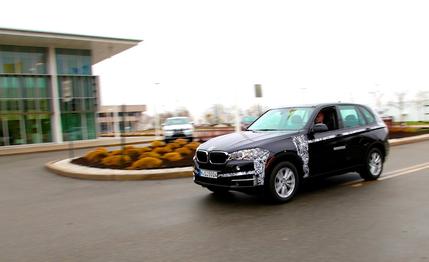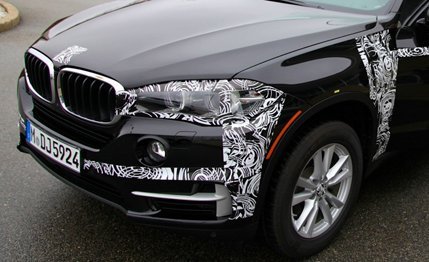
 Prototype Drive
Prototype Drive
On the heels of its unconventionally styled i3 and i8, BMW is launching a different breed of electrified vehicle, one that appears quite conventional to the casual observer. The plug-in-hybrid version of the X5—a car that BMW has nicknamed “the Boss”—is almost indistinguishable from its conventionally powered siblings, even sporting massive exhaust pipes. It was first shown at the Frankfurt auto show last fall, and now we’ve had a chance to slide behind the wheel of a prototype.
Whereas the regular X5 is available with six- and eight-cylinder engines, the plug-in hybrid makes use of BMW’s N20 2.0-liter turbocharged four. The 240-hp engine is mated to a ZF eight-speed automatic with a 95-horse electric motor in place of the conventional torque converter. Combined, they produce up to about 270 horsepower and 300 lb-ft of torque. This power level puts the plug-in hybrid close to the X5 xDrive35i with its turbocharged straight-six.
The greatest advantage of any plug-in hybrid, of course, is fuel economy, and this X5 is rated at a remarkable 74 mpg in the highly optimistic European cycle. Racking up big mpg numbers is crucial for Germanys premium carmakers in order to meet European emissions standards. This X5, if driven locally and over short distances, rarely needs to make a trip to the gas station; electric-only range is rated at up to 20 miles. On longer trips, however, fuel consumption likely won’t deviate far from that of a conventionally powered gas X5.


Electrically Boosted Boss
The electric motor of this X5 might not be particularly powerful, but it is torquey. Even in electric mode, the massive SUV accelerated briskly to city velocities, and it can achieve up to 75 mph powered solely by electrons. Beyond that, the electric motor is able to provide considerable boost to the output of the gasoline engine. This X5 feels quick, especially in Sport mode. Top speed is governed at 130 mph.
Attentive drivers will feel the X5 plug-in switching between gas and electric power, and they might also miss the linearity and melodic sound associated with BMW's straight-six engines. But many customers might not ever notice the workings of this plug-in hybrid’s sophisticated powertrain.
Indeed, BMW has gone to great lengths to mask the unconventional nature of the plug-in’s powertrain. One example is the lack of the "one-pedal feeling" that is a hallmark of BMW’s i3, which is to say, power regeneration so aggressive that merely lifting off the accelerator can provide ample deceleration. The X5’s energy regeneration is more aggressive while coasting in Sport mode, but it remains unobtrusive. Besides Eco Pro, Comfort, and Sport modes, this X5 offers a Save Battery mode, which preserves the charge level, and a Max eDrive mode that will be useful in city centers that limit or ban access by internal-combustion cars.


As with other such vehicles based on existing gas-powered cars, the X5 plug-in suffers a slight loss in trunk space; the load floor is higher to make room for a massive lithium-ion battery pack. The hybrid elements add considerable mass, which BMW engineers estimate to be 450 to 600 pounds. The X5 plug-in hybrid handles well, but that extra weight makes it somewhat clumsy in corners.
Engineered to mask the electrification under its skin, the eventual production X5 plug-in hybrid will appeal to buyers who see no need to flaunt their green leanings, but it is likely to be shunned by those drawn to the quirky i models (except, perhaps, as a model to own alongside an i3 or i8). This “Boss” seems to be a bit shy about its merits.